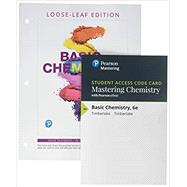NOTE: This loose-leaf, three-hole punched version of the textbook gives you the flexibility to take only what you need to class and add your own notes – all at an affordable price. For loose-leaf editions that include MyLab™ or Mastering™, several versions may exist for each title and registrations are not transferable. You may need a Course ID, provided by your instructor, to register for and use MyLab or Mastering products.
For courses in introductory, preparatory, and basic chemistry.
This package includes Mastering Chemistry.
Help students master math and problem solving they will use in their future chemistry classes
Basic Chemistry introduces Introductory Chemistry students to the essential scientific and mathematical concepts of general chemistry while providing the scaffolded support they need. The text uses accessible language and a moderate pace to provide an easy-to-follow approach for first-time chemistry students and those hoping to renew their study of chemistry. With Basic Chemistry , Bill and Karen Timberlake make the study of chemistry an engaging and positive experience for today’s students by relating the structure and behavior of matter to real life.
The 6th Edition presents a new visual program that incorporates sound pedagogical principles from educational research on the way today’s students learn and retain knowledge. The text’s applied focus helps students connect chemistry with their interests and potential careers through applications tied to real-life topics in health, the environment, and medicine. The new edition strengthens its emphasis on problem solving with additional end-of-chapter Challenge problems and new assignable practice problems that ensure students master the basic quantitative skills and conceptual understanding needed to succeed in this course and to continue their studies in the field.
Personalize learning with Mastering Chemistry
By combining trusted author content with digital tools and a flexible platform, Mastering personalizes the learning experience and improves results for each student.The fully integrated and complete media package allows instructors to engage students before they come to class, hold them accountable for learning during class, and then confirm that learning after class.
0134999908 / 9780134999906 Basic Chemistry, Loose-Leaf Plus Mastering Chemistry with Pearson eText -- Access Card Package, 6/e
Package consists of:
- 0134986997 / 9780134878119 Basic Chemistry
- 0134878876 / 9780134986999 Mastering Chemistry with Pearson eText -- ValuePack Access Card -- for Basic Chemistry








